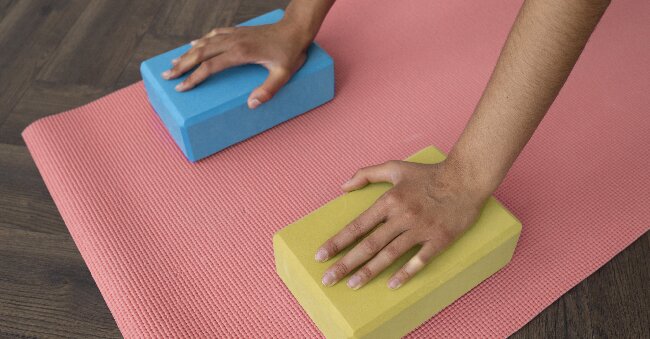
7 Powerful Tips to Extend the Lifespan of Your Yoga Bricks
A yoga enthusiast may aim to enhance their practice with the assistance of a yoga brick.
This exploration will cover the advantages of utilizing a yoga brick, the selection process for one that suits individual needs, and the significance of proper maintenance and care.
Additionally, it will touch upon typical errors to avoid when maintaining a yoga brick and offer guidance on recognizing when it might be necessary to acquire a replacement.
The focus will also be on methods to prolong the durability of a yoga brick and optimize its usefulness in practice.
What Is a Yoga Brick?
A yoga brick is a versatile piece of equipment commonly used by yoga practitioners to enhance their practice and deepen their stretches. It is typically made of foam, cork, or wood and comes in various sizes and shapes to cater to different needs.
Foam bricks are lightweight and provide a soft surface for support, making them ideal for beginners or those needing gentle assistance in poses. Cork bricks offer a more firm and stable base, perfect for advanced yogis looking for greater stability in balancing poses. Wood bricks, while heavier, offer excellent durability and can withstand heavier weight without losing shape. These variations allow practitioners at all levels to customize their yoga routines, improve alignment, and access deeper stretches with ease.
Why Use a Yoga Brick?
Using a yoga brick can enhance one’s yoga practice significantly by providing support, stability, and extension in various poses. It helps improve alignment, flexibility, and posture while reducing the risk of injury.
Incorporating a yoga brick into an exercise routine can lead to a myriad of benefits. The added support offered by the brick can help maintain proper alignment in challenging poses, allowing individuals to deepen stretches and reach new levels in their practice. Utilizing a yoga brick can enhance flexibility by providing leverage to access deeper stretches safely. This tool can also assist in developing better posture by encouraging proper spinal alignment and offering stability in balancing poses.
What Are the Benefits of Using a Yoga Brick?
The advantages of utilizing a yoga brick are numerous, such as improved stretching capacity, enhanced support in challenging poses, increased stability during balance exercises, and better alignment for proper posture maintenance.
These versatile props aid in deepening stretches, enabling practitioners to safely explore their range of motion. They are essential for maintaining stability during balance-focused yoga sequences by offering a firm foundation. Yoga bricks assist in achieving proper alignment by acting as a guide for positioning the body correctly in various asanas. Incorporating a yoga brick into practice promotes a more balanced approach, encouraging mindfulness and intentionality during each yoga session.
How to Choose the Right Yoga Brick?
When selecting a yoga brick, it is important to consider factors such as material, size, density, and texture. Choose a brick of high quality that meets your practice requirements and aligns with your comfort preferences to maximize its benefits.
When considering a yoga brick, the material is crucial as it affects durability and support during poses. Opt for bricks crafted from robust, eco-friendly materials like cork or foam for a lasting investment.
The size of the brick should complement your body proportions to assist in achieving proper alignment and posture. The density of the brick also plays a role in providing stability and resistance during various poses, making the selection process significant for your practice.
How to Properly Care for Your Yoga Brick?
Proper care and maintenance of a yoga brick are crucial to ensure its longevity and performance. Regular cleaning, appropriate storage, and preventing damage are key elements in preserving the quality and durability of the yoga brick.
Cleaning a yoga brick is a straightforward process; it can be wiped down with a damp cloth or cleaned using a mild soap solution to eliminate any dirt or sweat buildup. It’s important to make sure the brick is completely dry before storing it in a cool, dry area away from direct sunlight or moisture. By following these guidelines, you can prevent the brick from warping or developing unpleasant odors. A well-maintained yoga brick will not only have a longer lifespan but will also enhance your practice by providing the necessary support and stability.
1. Cleaning and Maintenance
It is important to clean and maintain your yoga brick regularly to prolong its lifespan and maintain its quality. Using mild cleaning solutions, gentle techniques, and adhering to a regular cleaning schedule will help keep your brick in optimal condition.
Routine maintenance of your yoga brick includes wiping it down with a damp cloth after each use to remove sweat and dirt accumulation. For a more thorough cleaning, you can create a mixture of mild soap and water and gently scrub the surface with a soft brush or cloth. It is recommended to avoid harsh chemicals or abrasive cleaning tools to prevent damaging the texture of the brick. Additionally, store your brick in a dry and well-ventilated area to prevent mold and odor buildup.
By following these maintenance practices, you can ensure that your yoga brick remains in good condition for an extended period of time.
2. Storage
Proper storage of a yoga brick is crucial to prevent breakage and preserve its shape. It is recommended to store the yoga brick in a dry area that is shielded from direct sunlight and heavy items to maintain its integrity and avoid damage.
To prevent the yoga brick from becoming brittle or misshapen, storing it in a cool environment is advisable. Avoid placing additional equipment on top of the brick to prevent unnecessary pressure that could result in cracks or fractures. Choose a storage location that is free of moisture, as dampness can compromise the material’s strength over time. By adhering to these storage guidelines, the yoga brick can be kept in optimal condition for extended use.
3. Avoiding Damage
Preventing damage to a yoga brick is essential to maintain cleanliness and ensure its durability. It should be handled carefully, avoiding impacts and cleaned regularly to safeguard its surface and prevent deterioration.
An effective strategy to prevent damage to a yoga brick is to store it in a designated area, away from sharp objects or heavy items that may cause scratches or dents. Using a clean towel or yoga mat underneath the brick during practice can reduce direct contact with sweat and dirt, thereby improving its cleanliness.
It is also advisable to refrain from excessive bending or twisting of the yoga brick during use, as this may result in cracks or breakage over time. By adhering to these protective measures and employing proper handling techniques, individuals can extend the lifespan of their yoga brick and preserve its cleanliness for an enhanced yoga experience.
What Are Common Mistakes in Preserving a Yoga Brick?
Several common mistakes can hinder the preservation of a yoga brick, such as using harsh cleaning products, storing it in direct sunlight, and placing heavy objects on top. Avoiding these errors is vital to extend its lifespan and prevent wear and tear.
Using harsh cleaning products on a yoga brick can cause damage to its surface and deteriorate its material over time. Similarly, exposing the brick to direct sunlight can lead to fading and weakening of its structure. Placing heavy objects on the brick can result in it losing its shape and structural integrity.
To ensure the longevity of your yoga brick, opt for gentle cleaning methods, store it in a cool and shaded area, and avoid subjecting it to unnecessary weight pressure.
1. Using Harsh Cleaning Products
One common mistake in preserving a yoga brick is using harsh cleaning products that can damage its surface and compromise its quality. Opt for mild solutions and gentle cleaning techniques to ensure longevity and prevent deterioration.
These harsh cleaning products often contain strong chemicals that can strip away the natural texture and resilience of the yoga brick over time. The porous nature of the brick can also absorb these harsh chemicals, which may emit harmful fumes during yoga practice. By switching to softer cleaning alternatives like a mixture of water and mild soap or vinegar, you not only protect the integrity of the brick but also create a safer environment for your yoga practice. Remember, a gentle touch goes a long way in maintaining the longevity of your yoga equipment.
2. Storing in Direct Sunlight
Storing a yoga brick in direct sunlight can result in discoloration, warping, and deterioration of its material. To prevent damage and maintain its quality, it is recommended to store the brick in a shaded area away from sunlight exposure.
Direct sunlight exposure may lead to fading colors of the yoga brick over time and could weaken the structural integrity of the material, potentially affecting its reliability for yoga practice. Prolonged exposure to sunlight can also impact the texture of the brick, potentially affecting the comfort level during routines.
By storing the brick in a cool, dark place when not in use, its lifespan can be extended, ensuring it remains a valuable tool in practice.
3. Placing Heavy Objects on Top
It is advisable to avoid placing heavy objects on top of the yoga brick to prevent cracks, deformities, and structural damage. It is important to safeguard the brick from excessive weight to maintain its integrity.
Yoga bricks serve the purpose of supporting your body during yoga poses, offering stability and balance. Placing heavy objects on them can compromise their structural integrity, increasing the risk of cracks and damages. It is essential to remember that these bricks are intended for supporting your practice, not for storing heavy items. By refraining from such practices, you can ensure that your yoga brick remains durable and continues to serve its intended purpose for an extended period.
How to Know When It’s Time to Replace Your Yoga Brick?
Recognizing the signs that suggest the need to replace a yoga brick is important for maintaining safety and performance standards. Indications such as visible damage, loss of shape or firmness, and unpleasant odors are signals that it might be time to get a new brick.
Damage on a yoga brick, like cracks or chips, undermines its structural integrity and could create hazards during use. When a yoga brick loses its original shape, becoming misshapen or uneven, it can impact your balance and alignment during poses. Unpleasant odors coming from the brick could indicate the presence of bacteria or mold, signaling a need for replacement to uphold hygiene standards. Regularly checking your yoga brick for these signs ensures a safe and effective practice.
1. Visible Damage
Visible damage on a yoga brick, such as cracks, tears, or deformities, indicates the need for replacement. It is recommended to regularly examine the brick for signs of wear and tear to maintain its safety and efficacy.
Failure to address signs of damage can result in potential hazards during yoga practice. For instance, cracks can weaken the structural integrity of the brick, jeopardizing its stability and support. Tears or deformities may impact the comfort and functionality of the brick. Prompt replacement is essential to uphold the integrity of yoga equipment and prevent injuries.
By proactively monitoring and addressing these indicators, individuals can ensure a safe and fulfilling yoga practice.
2. Loss of Shape or Firmness
A noticeable loss of shape or firmness in a yoga brick can affect its usability and effectiveness. When the brick no longer provides adequate support or stability, it may be necessary to consider replacing it for optimal performance.
Yoga bricks play a crucial role in achieving proper alignment and enhancing practice. When the shape begins to deform or the firmness decreases, the risk of injury during poses may rise. This deterioration can also impede progress in mastering challenging asanas. By maintaining the integrity of a yoga brick, one ensures consistent and reliable support for various exercises, facilitating deeper stretches and improved posture. Regularly checking the shape and firmness of a yoga brick is essential for a safe and rewarding practice.
3. Unpleasant Odor
A foul smell coming from your yoga brick suggests a hygiene issue and might necessitate replacement. Maintaining cleanliness and freshness is important to uphold a healthy environment for practice and avoid discomfort during yoga sessions.
It is recommended to regularly check your yoga brick for any persistent odors, as these could signal a bacterial buildup that may pose health risks. A clean yoga brick not only improves your overall experience but also enhances concentration and relaxation.
Opting for a high-quality, odor-resistant yoga brick can significantly enhance the cleanliness and pleasantness of your practice area, enabling you to fully engage in the tranquility of your yoga routine.
External Resource :https://nutroone.com/en/product/yoga-bricks/




No Comments